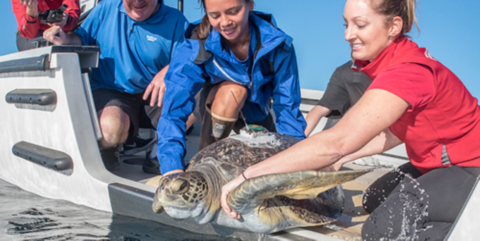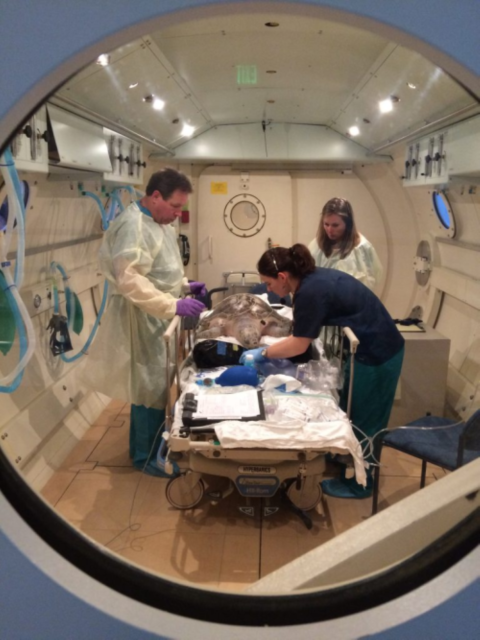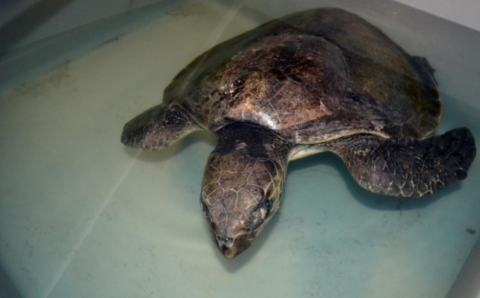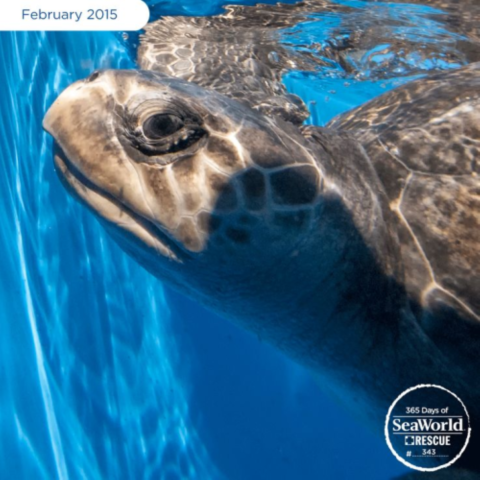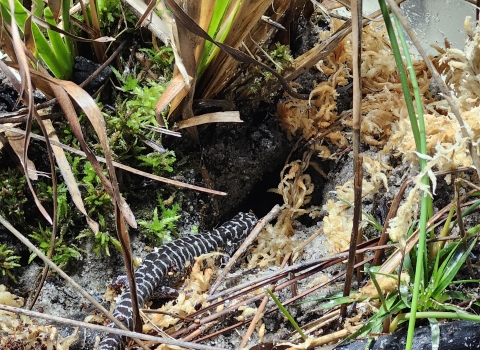This year is the 50th anniversary of the Endangered Species Act, a law that has been a powerful catalyst for conservation of America’s most treasured fish, wildlife, plants and their habitats. In the Pacific Region, our Tribes, state and federal agencies, and partners have joined with our dedicated staff to be the driving force behind the successes we share and the strength ensuring we can address the challenges ahead. Celebrate this milestone with us in this collection of stories as we reflect on past successes, assess current challenges, and envision an equally bright future for the next 50 years and beyond.
I’ve been asked, “What difference does one turtle make?”
It is absolutely true that one turtle, in comparison to the entire world’s population, represents a small contribution to that population. However, rehabilitating that one individual from an endangered or threatened population can ensure decades of offspring over a lifespan of up to 80 years.
Every turtle that strands and is treated, successfully or not, teaches us something. The first lesson they teach us is how to successfully respond, which is vital to know if we ever have a spill or catastrophe that causes mass turtle strandings. And erratic ocean conditions like algal blooms, El Niño, oxygen depletion, and warming sea surface temperatures are resulting in greater numbers of stranded turtles.
Additionally, many of the turtles we have treated are juveniles or very young adults. This age group is crucial as the future breeding population, and very little is known about them. The period between hatching and return to the nesting area is known as the “lost years” because when the turtles leave their nests, they are too tiny to track with conventional satellite equipment, and they are seldom encountered until the females return to nest 20 or more years later – unless we find them stranded. And males are even more mysterious since they spend their lives at sea.
And each stranded turtle we successfully release has a story with important lessons. A green sea turtle named Comber, stranded in Canada in 2015 and released in November 2016, was the first ever successful sea turtle rescue from Canada. With a satellite tag attached, Comber was released to the sea southwest of San Diego. He shocked us by heading straight back to Canada! When his transmitter finally failed on March 30, 2017, he was in British Columbia a few miles north of where he stranded, showing signs of normal turtle activity. He was able to swim over 1,500 miles in frigid waters in the dead of winter, and based on another turtle released in 2011, it may be more common than we know. Two turtles can tell a story, but we need more information to develop a pattern.
Hopefully, the pattern will fill in a bit more brightly this fall. Three sea turtles, stranded in December 2014 and 2015, are returning to the Pacific Ocean on September 11! All three will be equipped with satellite transmitters to map their travels. And all three have already provided us with valuable information, teaching us lessons in treatment of cold-stranding and buoyancy.
Bouyancy is a common problem for stranded turtles. Air becomes trapped under the shell or in their organs, and the turtle has difficulty expelling the trapped air. Bouyant sea turtles have difficulty diving, swimming, and feeding, and if unable to be successfully treated, cannot be released.
All three of the soon-to-be-released turtles had health issues that were difficult to resolve. Solstice’s severe buoyancy required almost 3 years and tenacious care to successfully treat. Lightning’s buoyancy problems were less pronounced, but her injuries and cold-stunning were critical. She had infections; pneumonia; several broken bones, including one at the base of her skull; and her eyes were so badly damaged we thought she had lost one or both eyes. With meticulous care at the Oregon Coast Aquarium and SeaWorld, her eyes healed, she underwent surgery to remove bone fragments in her neck, and she now feeds and rests comfortably at the bottom of her pool. Both of these young adult females are healthy and ready to return to sea.
Tucker was even worse. I drove him from Seaside Aquarium to Seattle to receive critical treatment, and by the time he was handed off to the Seattle Aquarium team, he looked dead. Veterinary staff spent two days manually breathing for him through a tube. He revived, but it was apparent he had severe pneumonia and buoyancy. He received a unique treatment in a hyperbaric chamber at Virginia Mason Hospital in Seattle where veterinary staff attempted a new technique to further expel gas from his tissues and blood. His improvement was nothing short of miraculous and provided us new potential solutions to a common problem in stranded turtles.
The road to recovery for these turtles was long, but the Seattle Aquarium, the Oregon Coast Aquarium, and SeaWorld San Diego all worked together to revive, treat, transport, and release them successfully. Together, with the National Oceanic and Atmospheric Administration, we all continue to support the science behind the treatment, recovery, and release of these threatened sea turtles.
The difference that a rehabilitated sea turtle makes is not just in its ability to reproduce or teach us lessons. Perhaps more importantly, turtles clearly have value to humans just as turtles. Witness the human connection to turtles in the millions of car decals and tattoos or the wonder expressed by visitors seeing a turtle on the beach in Costa Rica or Mexico or Hawaii. People love turtles. Sea turtles are seen as peaceful, wise, mysterious and interesting ocean ambassadors that travel the world and symbolize the great unknown sea. People want to help sea turtles live freely in their natural environment, whether it means recycling more plastic, cleaning up litter, improving fishing practices, or saving turtles that need human assistance. The public expects us to do our duty to work with others to conserve and protect sea turtles and their ocean habitat, and saving stranded sea turtles helps us fulfill that mission.
Story by Laura Todd
###
The U.S. Fish and Wildlife Service works with others to conserve, protect, and enhance fish, wildlife, plants, and their habitats for the continuing benefit of the American people. For more information, visit www.fws.gov/pacificislands, or connect with us through any of these social media channels at https://www.facebook.com/PacificIslandsFWS, www.flickr.com/photos/usfwspacific/, https://medium.com/usfwspacificislands or www.twitter.com/USFWSPacific.

